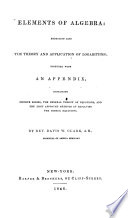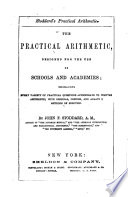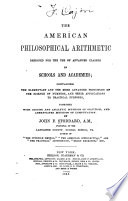 | Davis Wasgatt Clark - 1844 - 394 pages
...Thus, V^+Zpx 2—x+p, and vV— 2px-\-p2=x— p. 324. We have also seen that the square of a binomial is equal to the square of the first term, plus twice the product of the two terms, plus the square of the last term. Thus, And the square of the residual, x—... | |
 | Charles Davies - Algebra - 1845 - 382 pages
...has already been shown (Art. 46), that, (o + 6)2 = a2 + 2ab + 62 ; that is, The square of a binomial is equal to the square of the first term plus twice the product of the first term by the second, plus the square of tJie second. • The square of a polynomial,... | |
 | Davis Wasgatt Clark - Algebra - 1846 - 374 pages
...Thus, vV+2px +p 2 —x+p, and Vx'—Zpx+p'=x—p. 324. We have also seen that the square of a binomial is equal to the square of the first term, plus twice the product of the two terms, plus the square of the last term. Thus, Hence, if p2 be added to both members... | |
 | George Roberts Perkins - Algebra - 1847 - 432 pages
...multiplication, we find ~ +2(a+b+c)d+#+2(a+b+c+d)e+e°. &c. &c. From the above, we discover, that (102.) The square of any polynomial is equal to the square...term into the. second, plus the square of the second ; ptns twice the sum of fhefirst two into the third, plus the square of the third- plus twice the sum... | |
 | Joseph Ray - Algebra - 1848 - 252 pages
...negative. Hence, we see, that the square of any polynomial is formed according to the following law: The square of any polynomial is equal to the square of the first term— plus twice Hie first term, plus the second, multiplied by the second — plus twice the first and second terms,... | |
 | Joseph Ray - Algebra - 1848 - 250 pages
...the first member of this equation may always be made a perfect square. Since the square of a binomial is equal to the square of the first term, plus twice the product of the first term by the second, plus the square of the second ; if we consider x2+2px as the... | |
 | Joseph Ray - Algebra - 1852 - 408 pages
...whatever, either integral or fractional, positive or negative. This formula gives the following law: T!ie square of any polynomial is equal to the square of the first term — plus twice the Jirsl term, plus the second, multiplied by the second — plus twice the Jlrst and second terms, plus... | |
 | John Fair Stoddard - Arithmetic - 1852 - 320 pages
...square BHGF, whose side is BH, (or 5) ; hence, its area is i2. ART. 204. The square of ^ polynominal is equal to the square of the first term,, plus twice the first term inti (he Kamd, plus tin s'/uare of the second ; plus twice the. sum of the first two iitio the third,... | |
 | Joseph Ray - Algebra - 1848 - 250 pages
...the first member of this equation may always be made a perfect square. Since the square of a binomial is equal to the square of the first term, plus twice the product cf the first term by the second, plus the square of the second ; if we consider x*-\-2px as... | |
 | John Fair Stoddard - Arithmetic - 1856 - 312 pages
...square BHGF, whose side is BH, (or 5) ; hence, Is area is 52. ART. 236. The square of any polynominal is equal to, The square of the first term, plus twice the first term into tht second, plus the square of tht second ; plus twice the sum nf the first two into the third, plus... | |
| |